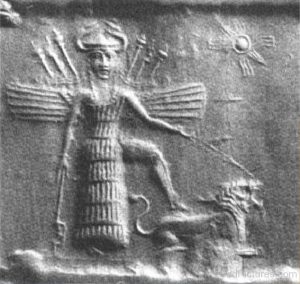It might surprise you to learn that one of the entities we hold responsible for the bloody state of the world today has been worshiped for five thousand years as the goddess of love.

In the Bible, she was called Astarte. Her name in ancient Sumer was Inanna, but we know her better as Ishtar, Aphrodite, and Venus. The brightly shining planet bearing her name represented her in the sky, and she’s been called “without a doubt the most important female deity of ancient Mesopotamia in all periods.”[1] Her reputation has been cleaned up a lot over the millennia; for one thing, she was indirectly connected to the Tower of Babel, which probably dates to the close of the Uruk Period of history near the end of the fourth millennium BC, sometime around 3100 BC.
Nimrod, usually identified as the builder of the Tower of Babel, was born in the second generation after the Flood. His father was Cush, son of Ham, son of Noah. The heart of Nimrod’s kingdom was Babel and Erech, which was the ancient city of Uruk. Its name is preserved today in the modern nation of Iraq. According to the Sumerian King List, the second ruler of Uruk after the Flood was named Enmerkar, son of Mesh-ki-ang-gasher. Interestingly, an epic poem from about 2000 BC called “Enmerkar and the Lord of Aratta” preserves the basic details of the Tower of Babel story.
We don’t know the exact location of Aratta, but guesses range from northern Iran to Armenia. Wherever it was, Enmerkar tried to muscle this neighboring kingdom into supplying building materials for a couple of projects that were near and dear to his heart.
Uruk was home to two of the chief gods of the Sumerian pantheon. One, the sky-god Anu, was the primordial deity overthrown by the first-generation cosmic ruler. In Greece, this was Ouranos; in Rome, the sky-god was Caelus, from whom we get the word “celestial.”
The other patron deity of Uruk was Anu’s granddaughter, Inanna. Here’s the thing: She wasn’t exactly the goddess of love; her areas of responsibility were actually war and sex. And by sex, we mean the carnal, extramarital kind.
Anu was depicted as more or less retired from direct oversight of humanity, having handed over his duties as head of the pantheon to Enlil. Inanna, on the other hand, played a very active role in Sumerian society. For example, she wasn’t just the goddess who assisted forlorn, would-be lovers; scholars have translated ritual texts—magical spells, to be honest—for innkeepers to ask Inanna to guarantee that their bordellos turned a profit.
Apparently, the dispute between Enmerkar and the king of Aratta, whose name, we learn from a separate epic, was Ensuhkeshdanna, was over who was Inanna’s favorite. One of the building projects Enmerkar wanted to tackle was a magnificent temple to Inanna, the E-ana (“House of Heaven”), and he wanted Aratta to supply the raw materials. There wasn’t much in the way of timber, jewels, or precious metals in Sumer, being mostly desert and marsh, but Enmerkar mainly wanted the lord of Aratta to submit and acknowledge that he was Inanna’s chosen one. So Enmerkar prayed to Inanna:
My sister, let Aratta fashion gold and silver skillfully on my behalf for Unug (Uruk). Let them cut the flawless lapis lazuli from the blocks, let them …… the translucence of the flawless lapis lazuli ……. …… build a holy mountain in Unug. Let Aratta build a temple brought down from heaven – your place of worship, the Shrine E-ana; let Aratta skillfully fashion the interior of the holy jipar, your abode; may I, the radiant youth, may I be embraced there by you. Let Aratta submit beneath the yoke for Unug on my behalf.[2]
Notice that Inanna’s temple was compared to a holy mountain. Having read this far into our series, you know that the conflict between the rebel gods and the Creator is over control of the mount of assembly, the holy mountain of God, Zion. Even in Sumer, where there aren’t any, mountains are sacred. Remember that one of the epithets of the chief god, Enlil, was “Great Mountain,” and his temple at Nippur was the E-kur, the “Mountain House.”[3]
Given the type of goddess Inanna was, the “embrace” Enmerkar wanted from her was more than just a figure of speech. While scholars still debate whether, and how often, it was performed, the so-called sacred marriage rite between Mesopotamian kings and the high priestess of Inanna/Ishtar, even if it was only play-acted, was a standard part of her cult.[4]
Most of the discussion of the rites of Inanna/Ishtar, especially the practice of cult prostitution, cite the work of the Greek historian, Herodotus, who wrote in the fifth century BC:
Surely the most disgusting of all Babylonian customs is the following. Once in her life, every woman of the country must sit down in the sanctuary of Aphrodite and have intercourse with a stranger.… the majority sit in the sacred precinct of Aphrodite wearing wreaths made of cord on their heads.… she may not return home until one of the strangers has tossed silver into her lap and has had intercourse with her outside the sanctuary. When he tosses the silver, he must say, “I call on you in the name of the goddess Mylitta.” (The Assyrians call Aphrodite Mylitta.)… the women cannot refuse, and the silver then becomes sacred property.… Then, after they have had intercourse and she has thus discharged her duty to the goddess, she returns home. But after this event, no matter how much you give her, she will refuse you.[5]
Scholars today generally dismiss that account. It’s believed Herodotus was trying to demonize the enemies of Greece. That’s understandable, since he was born about five years before the epic battle at Thermopylae where Leonidas and his Spartans made their famous stand against the Persians.[6] Portraying the depravity of Mesopotamians would have been popular reading among the Greeks back in the day.
That said, an Old Babylonian text first translated and published in 1997[7] seems to confirm at least some of the Bible’s negative characterizations of Inanna’s Canaanite counterpart, Astarte, including cult prostitution, “cross-gender activities…and the performance of sexual acts.”[8]
Since we’d like to keep this family-friendly, we won’t dig much deeper into the personality of Inanna, but it’s safe to say she definitely was not a girl you’d bring home to meet your mother. In fact, she wasn’t always a girl, period.
You see, while Inanna was the goddess with the mostest when it came to sex appeal, she was also androgynous, sometimes depicted with masculine features like a beard. On one tablet from the first millennium BC, probably some three thousand years after Nimrod, Inanna says, “When I sit in the alehouse, I am a woman, and I am an exuberant young man.”[9] Her cult followers included eunuchs and transvestites, and she was apparently the first in history to make a practice of sex reassignment:
She [changes] the right side (male) into the left side (female),
She [changes] the left side into the right side,
She [turns] a man into a woman,
She [turns] a woman into a man
She ador[ns] a man as a woman,
She ador[ns] a woman as a man.[10]
It’s incredibly ironic. The twenty-first century progressive ideal of gender fluidity was personified five thousand years ago by the Sumerian goddess Inanna. She’s celebrated by modern scholars as complex and courageous, transcending traditional gender roles, turning Inanna/Ishtar into an icon of independent man/woman/other-hood.
(That) a man is like a woman, a maiden is a young man,
you have put his offspring in the gutter—are yours, Ishtar…
(That) a m[an goes] the way of a woman,
a woman [goes] (the way) of a man, [—are yours, Ishtar]…
You make men obey (the rules of) garments (and) wigs.
At night, the women are touched. They are untidy regarding the hair-locks.
The woman, like a man, is equipped with a quiver, she holds a bow.
The man carries a hairpin, a siBtum, an uḫḫu, a harp.
The women are carrying bows, slings, sling-stones.[11]
What gender activists don’t realize is that Ishtar’s act was already old when Moses came down from Mount Sinai with the Law. What God taught the Israelites was new.
A woman shall not wear a man’s garment, nor shall a man put on a woman’s cloak, for whoever does these things is an abomination to the Lord your God.
Deuteronomy 22:5 (ESV)
You see, deconstructing God’s appointed gender roles isn’t progressive. It’s regressive. Gender activists are trying to turn back the clock about five thousand years.
A word about that verse in Deuteronomy: It’s been misinterpreted by some Christians as God’s command that women should not wear pants. That’s not what it means.
First, the Hebrew word kǝlî doesn’t necessarily mean “garment.” It can mean “piece of equipment,” “article” or “object”—basically, “stuff.” In this context, the word refers to items that are gender-specific—like quivers, bows, and slings for men, or a hairpin, harp, and uḫḫu for women (whatever that is).
In other words, the Law simply says men shouldn’t try to be women and vice versa. It’s a pretty good bet that the verse cited above was specifically directed at Inanna/Ishtar. Her cult was very old, it extended over the entire biblical world, and shattering God’s boundaries for gender was a key element of her cult.
[1] Eiko Matsushima, “Ištar and Other Goddesses of the So-Called ‘Sacred Marriage’ in Ancient Mesopotamia.” In David T. Sugimoto (Ed.), Transformation of a Goddess: Ishtar – Astarte – Aphrodite (Fribourg: Academic Press; Göttingen: Vandenhoeck & Ruprecht, 2014), 1.
[2] Black, J. A., Cunningham, G., Fluckiger-Hawker, E, Robson, E., and Zólyomi, G. “Enmerkar and the Lord of Aratta.” The Electronic Text Corpus of Sumerian Literature (http://etcsl.orinst.ox.ac.uk/cgi-bin/etcsl.cgi?text=t.1.8.2.3#), retrieved 12/17/16.
[3] Although the Sumerian word kur also meant “underworld,” an interesting dual meaning given “the” god’s links to the underworld, as discussed in chapter 8.
[4] Matsushima, op. cit., 3.
[5] Herodotus I 199, cited in Jerrold S. Cooper, “Sex and the Temple.” Kai Kaniuth, Anne Löhnert, Jared L. Miller, Adelheid Otto, Michael Roaf and Walther Sallaberger (Eds.), Tempel im Alten Orient (Wiesbaden: Harrassowitz Verlag, 2013), 49–50.
[6] Contrary to popular history, Leonidas had more than three hundred men. Herodotus estimated about five thousand; modern scholars put his forces at around seven thousand. Although it wasn’t as impressive as what Gideon did with the original three hundred, Leonidas and his men were still outnumbered at least twenty-to-one.
[7] Designated AO 3065 and housed at the Louvre in Paris.
[8] Michael P. Streck and Nathan Wasserman, “The Man Is Like a Woman, the Maiden Is a Young Man: A New Edition of Ištar-Louvre (Tab. I-II).” Orientalia 87 (2018), 5–6.
[9] Black, J. A., Cunningham, G., Fluckiger-Hawker, E, Robson, E., and Zólyomi, G., “A cir-namcub to Inana (Inana I),” The Electronic Text Corpus of Sumerian Literature (http://etcsl.orinst.ox.ac.uk/cgi-bin/etcsl.cgi?text=t.4.07.9&charenc=j#), retrieved 12/17/16.
[10] A. W. Sjoberg, “In-nin Sa-gur-ra: A Hymn to the Goddess Inanna,” Zeitschrift fur Assyriologie 65, no. 2 (1976), 225.
[11] Streck and Wasserman, op. cit., 17–19.


Thank you and God bless you, Brother Gilbert, for the insightful message. The content is informing my way going forward.
I would like to subscribe to your emails. Please let me know how I can do this.
Karen
Thank you for asking! Go to the “subscribe” box on the front page of the website, right below the “donate” button.